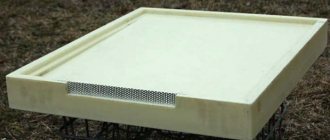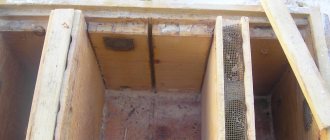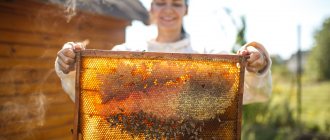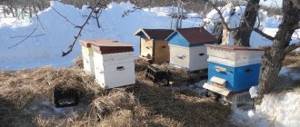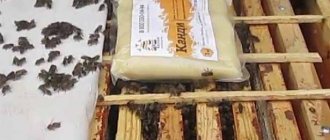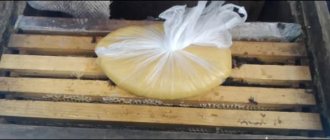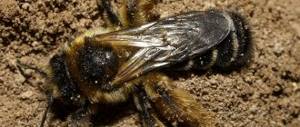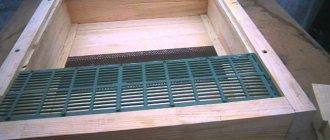Pros and cons of mobile beekeeping
A mobile apiary has a number of advantages:
- helps improve the pollination of honey plants (both agricultural and wild) and increase the area they cover;
- due to the variety of nectar sources, the resulting honey has a high content of microelements;
- the beekeeper can choose which plants to place the hives near to obtain the desired type of honey;
- bees receive more nutrition, which is beneficial for their viability and family growth;
- nomadic beekeeping allows you to extend the honey harvest season, covering a range of honey plants with different flowering periods.
The downside is the need to carefully ensure that the hives do not shake during transportation, otherwise some of the bees may die. Shaking can be minimized by carefully fixing the hives themselves, monitoring the smoothness of the driving process and thinking through routes, trying to choose smooth roads.
Also, under no circumstances should the hives be covered, especially at high temperatures. Bees require a sufficient amount of oxygen, and its deficiency can lead to the death of insects.
>
Nomadic apiary on wheels: how to assemble it yourself, review of mobile trailers
Fields of honey plants are often located at a considerable distance from the beekeeper’s home, as a result of which he thinks about purchasing a trailer for transporting bees.
When transporting hives, the goals are to minimize their shaking and transport as many bee houses as possible at one time. The question arises what characteristics the trailer should have for this.
Types of trailers for transporting beehives
There are several options for beekeeping trailers, differing in design features. Below are the types of trailers for transporting hives.
Lightweight bee trailer
If the number of hives is small, an on-board apiary on a car can be organized using a simple trailer used for transporting goods. A light-duty bee trailer has enough space to accommodate two dozen hives with insects.
They can be kept there throughout the honey plant flowering season. Having purchased such a model, the beekeeper undergoes modifications to it - he equips the roof, mounts a mechanism to simplify the installation of bee houses and remove them from the trailer.
Light bee trailers are convenient due to their low weight and ease of transportation. The downside of this option is that the hives are subject to significant shaking when moving, and care must be taken to secure them properly with straps. Additionally, these trailers are less spacious than other types and will require multiple trips to transport a large number of bee houses.
Pavilion for bees
The design of the pavilion is not tied to transport and provides the opportunity for permanent residence of bee colonies. A space of five square meters can accommodate fifty hives.
Pavilions are:
- stationary (not suitable for mobile beekeeping);
- on wheels (suitable for wandering and moving hives closer to the places where the necessary plants grow for insects to collect nectar);
- cassette (equipped with compartments for installing hives).
Platform for transporting bees
The bee platform is best suited for organizing a nomadic apiary. It is purposefully designed for transporting bees and allows placing hives to be transported over long distances and has the greatest productivity in terms of honey collection volume: even in regions poor in honey plants, you can get 50 kg of honey.
The installation, equipped with sides and stands, can accommodate up to 50 hives. Double-tier units are also available for sale.
Platform advantages:
- no need to load and unload hives;
- the possibility of equipping the system with a roof that protects from precipitation and sun;
- less pronounced shaking of bees when driving (compared to light trailers) due to the lighter weight of the installation - thanks to this, the insects feel calmer, and traveling does not become stressful for them;
- Thanks to the larger usable area, more hives can be transported at a time.
How to assemble a bee trailer with your own hands: 5 steps
A do-it-yourself bee trailer, suitable for a passenger car, can be made using the following components and tools:
- round and rectangular pipes;
- frame for the frame;
- corners and panels made of plastic;
- boards and sheets of metal for the floor;
- grinder;
- electric drill;
- apparatus for welding parts;
- hand tool.
Sequencing:
- Pipes with an angular cross-section are welded to the frame. The design is equipped with spring elements and springs.
- A frame is made from a rectangular tube (dimensions 180 cm by 240 cm) and connected to the frame frame. Retractable sleds are also made from the same type of tube.
- The corners mark the location of the hives and attach the wheels.
- The floor is constructed by connecting a board (top of the floor) to a metal sheet (bottom). Weld the racks.
- Using the corners, they arrange a mount for the future roof, which is made from plastic panels.
Choosing a trailer for transporting bees: a review of three models
Popular models of structures for transportation include:
Biaxial galvanized MZSA 817730.001
Its bottom is made of plywood treated with a water-repellent composition with a laminate coating. The trailer itself is covered with the same plywood.
The model is equipped with a folding mechanism. The largest total weight of transported cargo is 950 kg. The design is characterized by excellent stability due to biaxiality and a special drawbar.
"Beekeeper" from
The bottom is also made of plywood impregnated with a moisture-resistant compound. The height of the sides is 15 centimeters. Maximum cargo weight is 1000 kg. It has two axles, a strong frame and spring suspension, which makes it a good choice for uneven roads and reduces shaking of the hives during transportation to a minimum.
Tandem trailer
The trailers produced in Kurgan are equipped with automatic rolling wheels and belts that secure the hives. Also included is a spare wheel.
The height is optimized for easy removal and placement of hives. A wide trailer allows you to leave space between the rows of placed hives. During transportation, only one tier of hives can be installed, but when the trailer is stationary, it is permissible to place a larger number of them - up to four.
Pros and cons of mobile beekeeping
A mobile apiary has a number of advantages:
- helps improve the pollination of honey plants (both agricultural and wild) and increase the area they cover;
- due to the variety of nectar sources, the resulting honey has a high content of microelements;
- the beekeeper can choose which plants to place the hives near to obtain the desired type of honey;
- bees receive more nutrition, which is beneficial for their viability and family growth;
- nomadic beekeeping allows you to extend the honey harvest season, covering a range of honey plants with different flowering periods.
The downside is the need to carefully ensure that the hives do not shake during transportation, otherwise some of the bees may die. Shaking can be minimized by carefully fixing the hives themselves, monitoring the smoothness of the driving process and thinking through routes, trying to choose smooth roads.
Also, under no circumstances should the hives be covered, especially at high temperatures. Bees require a sufficient amount of oxygen, and its deficiency can lead to the death of insects.
Source: https://DomaFerma.com/pchyoly/obustroystvo-ulya/pricep-dla-perevozki-pcel.html
Features of using trailers
The main options for transporting hives are trailers, platforms and pavilions. They are sold ready-made. But due to the high cost, beekeepers often prefer to make them themselves. This saves money and allows you to take into account the characteristics of the hives and climatic conditions.
There are rules and conditions for transportation and installation:
- It is better to transport bees in early spring and autumn, when they are active and full of strength to fly around a new place (early spring is considered the ideal time, since the hives do not yet have heavy frames with honey and there are no new honeycombs);
- the new place should not be close to the old one, otherwise part of the bees, or even a whole family, may return to their original place;
- the distance from competitors must be at least 3 km;
- the mobile platform is installed in a place where the bees will be provided with clean water;
- The mobile apiary is installed parallel to the honey-bearing areas and must be protected from the wind and scorching sun.
This is interesting: Sowing cucumbers for seedlings - we look at them step by step
Rules for transporting hives
Bees are transported at night. A place is chosen that is at least 2 km away from the neighboring apiary. It is optimal to start transporting bees in the spring and finish in the fall. Insects adapt better to a new place. During transportation, the frames are reinforced with pegs and good ventilation is provided through the entrance.
Choose a place for the apiary that is protected from the wind by trees. A source of water is desirable. In hot weather, the brought hives are installed in the entrances to the north. If the weather is cold, turn south. The entrances are opened after the bees have calmed down, after about 20 minutes.
Mobile platform
One of the types of trailer is a platform for transporting bees
It is made on the basis of the chassis of a factory trailer, observing an important condition - not to violate the platform width permitted by traffic regulations. Therefore, in order to be able to transport a large number of hives, it is lengthened
A platform trailer is a low-cost option for an apiary if you make it yourself. In addition, it attaches to any car and can accommodate up to 50 hives.
This type of structure for transporting bee colonies has a number of advantages over a pavilion and a car trailer:
- It is less susceptible to shaking when moving than a trailer, which means it is more comfortable for bees;
- the design can be either single-tiered or multi-tiered, depending on the number of bee colonies;
- the hives are not lowered to the ground, which clearly makes the beekeeper’s work easier;
- In case of rain and as protection from the sun, a roof can be easily installed on the platform.
Building a platform yourself To build a platform with your own hands you will need:
- car trailer (OZPT);;
- square pipe 2.5x5 cm - 1200 cm;
- square pipe 2x4 cm - 2400 cm;
- corners 4x180 cm - 3 pcs.;
- corners 3.5x240 cm - 2 pcs.;
- pipe 20x240 cm - 3 pcs.;
- plastic panels 10x180 cm - 24 pcs.;
- a sheet of thin iron equal to the size of the platform;
- profile - 1 m;
- bearings - 8 pcs.;
- plastic roof panels;
- welding inverter;
- square;
- boards.
Springs
Once the tools and materials are prepared, you can begin building the platform with your own hands.
Frame, hinges, floor
The trailer frame is extended by one meter with square metal pipes using welding. Springs with a spring from a UAZ are installed on the bridge.
Retractable middle part on skids
A frame 240x180 cm is made from metal pipes (2.5x5 cm), which is secured with square pipes. The bottom of the frame is covered with a sheet of iron.
Installation of a roof from corners and panels
Having divided the entire frame into three parts, the middle one is made retractable on a slide made of a 2x4 square pipe. Then the hinges are welded to secure the hives. The drawbar is reinforced with a 4x150 cm pipe. The last stage is the construction of the roof using corners and plastic panels.
These are approximate instructions for building a platform, which, if desired, can be supplemented and changed at your discretion. There are a huge number of alternative options with different approaches and design features.
Types of mechanisms for transporting hives
Devices of various designs and modifications are used to transport bee colonies. The most popular options include a regular car trailer, a specially equipped pavilion and a platform.
Lightweight bee trailer
For a small number of hives, a regular car trailer is used, which is used for transporting household goods. A standard design can accommodate about 20 honey bee homes. In order to regularly use a trailer as a transport device for hives, it is necessary to additionally equip a roof and a special mechanism for loading and unloading cargo.
Trailers for passenger cars are characterized by low weight and easy operation. But when transporting the hive, it is necessary to secure it tightly to prevent them from shaking. Trailers are not as spacious as regular cars, so transporting more than 20 honeybee homes requires several trips.
Trailer-pavilion for bees
The bee pavilion is not tied to the car, so it is used for the permanent residence of bee colonies in a certain area. The capacity of the structure is up to 50 hives.
Types of pavilions:
- Stationary. The devices are not equipped with wheels, so they cannot be transported.
- Cassette. Equipped with compartments to accommodate hives.
- On wheels. Suitable for transporting bee dwellings to places close to honey bases.
Platform for transporting bees
The platform is designed for mobile beekeeping. Its design makes it possible to transport hives over considerable distances. The installation is equipped with racks and sides. There are two-tier models on the market. The capacity of the device is up to 50 hives.
Platform advantages:
- Less shaking while driving, since the platform has a small mass;
- No need to load and unload bee houses;
- A roof can be attached to protect bee colonies from adverse weather conditions.
DIY bee platform
A bee platform is considered the best option due to the larger capacity of the hives. In addition, the houses remain standing on the towbar after arriving at the parking lot.
Drawings, tools, materials
When making the platform, you will need similar tools and materials that were used to assemble the trailer. The drawing differs in size. The platform must be equipped with two wheelsets and high removable sides. If desired, a roof and a retractable platform can be made.
Build process
To obtain a platform, standard passenger car trailers for beekeeping are modified:
- First of all, lengthen the frame by at least 1 m by welding additional blanks from the profile and pipe.
- The bridge and springs are used from a UAZ car.
- The frame is visually divided across into sections. Usually there are 3 of them, each 60 cm wide. A retractable frame for hives is welded from a square pipe. They put it on a sled.
- Frames are welded from a corner under the hives and attached to the platform. The bottom is welded with sheet metal.
- The wheels of the retractable mechanism of the general frame for hives are made of bearings. They are distributed evenly throughout the structure.
- The floor of the platform is made of boards. Loops are welded along the side sides to tighten the hives with ribbons.
- The side posts are welded at the corners of the frame and in the center where the slides are located. The platform drawbar is reinforced with a pipe with a cross-section of 40 mm.
- The roof frame is welded from the corner. Be sure to maintain a slope so that rainwater drains.
The final stage of the work is laying the roofing material. Typically, tin, galvanized, and corrugated sheets are used.
DIY platform for bees
The platform has many advantages over other types of devices for transporting beehives. Another important advantage of the bee platform is the ease of installation with your own hands.
To organize a homemade platform you will need to prepare:
- Factory car trailer;
- Square pipes with dimensions 2.5x5x1200 cm, 2x4x2400 cm;
- 3 corners with dimensions 4x150 cm and 2 – 3.5x240 cm;
- 24 plastic panels measuring 10x180 cm;
- 3 pipes, diameter 20x240 cm;
- Sheet of iron according to the size of the platform;
- 8 bearings;
- 1 m profile;
- Square;
- Wooden boards;
- Welding equipment.
On a note. In order not to make mistakes when welding elements, you should definitely take the time to complete a clear drawing indicating all dimensions.
After all the equipment is ready, you can start making the platform with your own hands.
Instructions:
- Using metal pipes, the trailer is extended by 1 m.
- Springs from a regular UAZ should be installed on the trailer axle.
- A frame with parameters 240x180 cm is made from pipes with dimensions of 2.5x5 cm, the bottom of which is covered with a sheet of iron.
- The entire frame is divided into 3 identical parts. The central part is made retractable for convenience. To do this, use a 2x4 pipe sled.
- Now you can weld the hinges to secure the hives. The drawbar is secured using a 4x150 pipe.
- The last stage will be the construction of a light roof that will protect the houses with insects from scorching rays and precipitation.
Important! Above is an approximate version of creating a platform for transporting bees with all sizes and parameters. Depending on personal preferences and requirements, the design can be transformed and modified.
Popular models
The market has its own leading group. The rating was compiled based on demand and feedback from beekeepers themselves, as well as the opinions of experts in this industry.
The list includes those trailers that are designed for passenger cars and can be used both for transportation and for seasonal maintenance of bee houses.
MZSA
Specifically considering model 817730.001
This is a two-axle trailer with excellent stability, which does not sway while moving, which is important for the peace of mind of bees when moving
The bottom is made of moisture-proof plywood and laminated coating. Suspension of rubber-harness type. Easily transports up to 950 kilograms, has both folding sides.
The platform has dimensions of 3784x1720x792 mm.
This model costs from 65 thousand rubles.
Tandem
Model produced by the Kurgan trailers company. Also a two-axis design, which is very common among beekeepers.
The trailer has a large width, which allows you to arrange the hives in two rows while maintaining space between them for movement, movement and storage of auxiliary equipment.
Designed to transport cargo weighing up to 450 kilograms. The suspension here is spring-damping. And the dimensions are 5300x2070x1300 mm. The set includes an automatic wheel, belts, and ties.
When organizing a permanent place for collecting honey, the hives can be stacked in 3-4 tiers.
The price of the trailer is slightly higher, and starts from 89 thousand rubles.
7135 Beekeeper
Trailer manufactured by Progress. Due to the 15 cm high sides, it is easy to unload and load the hives.
A spring suspension is used, which is better suited for bad roads. The ride is soft, regardless of the road surface.
Carries cargo weighing up to 560 kilograms. Body dimensions range from 2500 to 3800x1400x150 mm. Due to the frame and two axles, it can load up to 1000 kg. Costs at least 79 thousand rubles.
Saddle apiary 24
Product of the company Axis. Designed to transport 24 bee houses. An excellent solution for nomadic use when you need to move from place to place in search of honey plants.
The design allows hives to be laid in several rows without disrupting air circulation. The load capacity here is 1500 kg. Additionally, there is a retractable cassette that can accommodate 8 houses.
With all its excellent characteristics, such a trailer costs from 65 thousand rubles.
This is not the entire list of bee trailers that beekeepers can use. Therefore, the choice is always yours.
Thank you all for your attention!
Thanks for reading! Please,
Nomadic apiary
As you know, many beekeepers keep their bees only in stationary apiaries, but in such cases, it is rarely possible to provide the insects with a good honey supply. That is why almost the majority of domestic beekeepers are nomads.
How to organize such an apiary?
All beekeepers who want to harvest a large harvest of honey products and increase profits from this type of activity think about the possibility of having a mobile, convenient apiary.
As practice shows, it is an apiary on wheels that helps increase honey yield by almost 40% more than a stationary one. This is especially true in the spring. With its help, hives can be transported to large areas of honey plants.
Moreover, the most valuable is honey that is collected from just one type of plant, and only a mobile bee apiary can help achieve this.
Hive in a trailer
Of course, it is difficult to replace a special bee pavilion, but still, a regular car trailer (as in the photo) can be useful for organizing migrations. A booth-type trailer will best cope with this task.
If there is no such thing, and a regular onboard one is available, it’s also not a problem. In this case, you will have to build the hanging booth yourself. You will learn further how to do this thanks to simple instructions and educational video materials.
If you have a tent trailer, you can immediately start preparing the interior; if you have a regular trailer, then we’ll make a canopy.
To do this, we make a frame using wooden slats, then you can build a “booth” with plywood or, again, wooden boards, and cover the roof with a steel sheet or other roofing material, for example, slate. Then the internal space needs to be divided into two parts according to the size of the hives and leave room for passage. For more capacity, it’s good to come up with a second tier.
Internal structure
Inside, the shelves and all fastenings for the hives need to be made strong and strong, because when moving from place to place, you need to be sure that the bee houses are well secured and do not wobble. You should also provide the necessary openings for insects to fly out onto the bribes.
In the trailer, their size should match the size of the hive openings. If everything is ready, a suitable place for moving has been chosen, then you can safely install the evidence, secure it and transport it to the honey plants. The beauty of using such mobile apiaries is that the hives do not need to be constantly loaded and unloaded upon arrival. It is enough to place the trailer in the right place for the insects to start taking bribes.
Homemade platform
One of the most successful options for organizing a mobile apiary is a platform. You can purchase it ready-made or build it yourself, which is a very profitable and good option.
A conventional platform, as we know, is a four- or two-wheeled platform with a special frame and mounts for hives. Usually they can be used to install bee houses in several tiers. Such platforms are attached to any car and are very convenient for transportation.
To make it with his own hands, the craftsman needed levers with hinges, spring struts, shock absorbers, wheels from a car with independent suspension and steel parts for the base.
A metal frame is installed along the required perimeter, to which a base with wheel axles is attached. Next, the only thing left to do is to attach wheels, shock absorbers, suspension and mounts for the hives. Such a platform is often called an apiary cart.
Pavilion for wandering
A beekeeping pavilion today is one of the most popular and affordable methods for organizing an apiary on wheels. They are simple covered and closed. Covered pavilions are essentially the same carts, only with a roof and fenced bars. Closed pavilions are already a solid structure that maintains a constant temperature in the hives, since they are of a closed type.
Ordinary pavilions have special openings opposite the entrances through which insects fly. Another type - a cassette pavilion is considered one huge hive on wheels. It has special retractable cassettes where bee families are placed.
Features of nomadic apiaries on wheels
Transporting bees from place to place has a number of its own rules and features. Do not forget that in one place there may also be competitive apiaries nearby (within a radius of 3 km), so keep your distance and remember various formalities. Place your bee houses so that they can be easily approached and controlled.
The bees should have access to clean, fresh water close to the site. Also choose a place to park your apiary on wheels in quiet places where there will be no strong winds or scorching sun rays. By the way, the light should be moderate, so it is best to choose slightly shaded places.
Proper placement of hives
Arranging the hives and placing them on the transport cart turns out to be of great importance. It is important to remember that bees, flying on one honeybee, acquire a similar smell; they are easily accepted even by people other than their families. Insects can get confused, fly into a “strange” hive, suffer from theft, and pile up in the outer hives.
Especially in windy or rainy weather, toilers can fly into the entrance closest to the bribe. That is why it is important to place all the houses parallel to the bribe at the same distance. It is advisable to place them in a row on one strip. If this is not possible, then it is better to put it in two rows.
Also, to better guide insects and remember their “home,” experts advise painting evidence in different colors.
How to set up a nomadic apiary
Having decided to use a traveling apiary, study the list of documents permitting this type of activity. It is mandatory to fill out a veterinary and sanitary passport for an apiary. This document gives permission to carry out any actions - transportation of hives, sale of honey, queen bees, purchase of families, etc.
Seven sections include information about the owner of the apiary, its description, location, characteristics of families, number of hives, sanitary condition and health of insects, a list of preventive measures, results of laboratory tests of bees, honey, beebread, etc.
You can obtain the document at the regional veterinary station. The farm is first inspected by a veterinarian, takes samples for analysis, and gives an opinion on compliance with sanitary standards and rules. If there are no complaints, a passport with a doctor’s signature and stamp is issued.
Every beekeeper should know exactly how to obtain an apiary passport and what activities should be carried out on his farm before the inspection.
Before departure, you must complete one of the sanitary documents presented below:
- Veterinary certificate (form No. 1) - required for transporting bees outside the area of residence to any place in Russia. It is drawn up in a veterinary institution subordinate to the executive authorities of a constituent entity of the Russian Federation, signed by the head or doctor who has the authority to do so, and certified by a seal.
- Veterinary certificate (form No. 4) - required for transporting bees within the area of residence. It is drawn up in a veterinary institution subordinate to the executive authorities of a constituent entity of the Russian Federation, signed by a doctor, and certified with a seal.
- Veterinary certificate (form No. 6.1).
If a mobile apiary is planned in the forest, then you should know Article 38 of the Forest Code. According to this document, apiaries can be located in forest lands on the basis of lease agreements with institutions on whose territory the forest is located.
The regions of the Russian Federation have their own laws that you need to know and follow.
In addition, you must have a permit to drive a vehicle with a trailer and open the appropriate categories. The trailer must be provided with license plates, traffic police documents, and the permissible weight without load is 750 kg.
Even more requirements are imposed on documentation and activities if the apiary is used as a business.
Transport platform
Any platform - purchased or homemade - is the best option for transporting insects. This is a classic trailer (one- or two-axle), on which special sides and racks, fastenings, etc. are installed. This allows it to be easily transported by any vehicle.
The platform is light weight, so it is not so subject to shaking. You can make a single or multi-tiered structure for transporting large apiaries with over 50 families.
The platform is very convenient to use. We found a new point for honey collection, simply hooked up the entire apiary to the car and drove there for any length of time. The platform can be used in any climate zone and in any weather - you just need to stretch the mesh or install some kind of covering. Transporting bee packages and hives with bees in this way is the best solution today.
Platform for transporting bees: types, models of nomadic apiaries, how to make a trailer with your own hands
To collect honey, bees need a honey base (flowering trees, bushes, etc.). Usually the fields are far from home and the location has to be changed when the flowering period of certain plants ends. To transport the hives, a special trailer for transporting bees is used. You can buy a ready-made device on the market or make the unit yourself.
How to assemble a bee trailer with your own hands
To make a trailer for transporting bees with your own hands, you first need to make a drawing. You will also need a ready-made cart or cart-like structure. Beekeepers recommend using a trailer. For example, a trailer from OZPT-Sarmat.
So, to make a trailer you will need:
- profile pipe 25×50 mm. - 12 m;
- profile pipe 20×40 mm. - 24 m;
- corners 4×180 mm. -2 pcs.;
- corners 4×60 mm. -10 pieces.;
- iron loops - 10 pcs.;
- round pipe 20×240 mm. - 3 pcs.;
- plastic panels 10x180 cm - 20 pcs.;
- a sheet of steel, the size of which is calculated according to the drawing depending on the dimensions of the product;
- bearings - 8 pcs.;
- plywood 16 mm thick. for forming the bottom in a trailer;
- welding machine.
The first stage of making a trailer for bees will be to increase the length of its base by 1-1.5 m. For this you will need a profile pipe. After this, you need to install the chassis on the trailer itself.
Step-by-step instructions for assembling the trailer:
First of all, you need to make a base frame for the trailer. Here you will need a 25x50 mm profile pipe. The dimensions of the finished structure should be 2.4x1.8 m
IMPORTANT! To ensure maximum reliability of the trailer, 20x40 mm profiles must be secured every half meter. The pipes must be welded across the base of the trailer. The next step is to secure the resulting structure directly to the trailer frame
For this you will need a welding machine. After the welding work is completed, divide the resulting structure into 3 parts and apply markings. Next you need to create a moving sled designed to accommodate hives with bees. From a profile pipe 25x50 mm. you need to cut and make a movable slide. Next, use 4x60 mm corners. you need to make places to place the hives. This is done by welding corners to the bottom of the trailer. There should be 5 places for hives on each side. Considering the placement of the newly welded corners for the hives, secure 5 loops on each side at their level using a welding machine. They serve to secure hives loaded onto a trailer and ensure the safety of transporting bees. The next step is to line the bottom of the resulting structure with a sheet of iron. IMPORTANT! Determine in advance the required dimensions of the metal, based on the drawing of the finished trailer. The next step will require bearings. Distribute them evenly on the structure frame. This will ensure the mobility of the sled. Now that the main moving parts of the trailer are ready, it is necessary to line the bottom of the structure with 16 mm thick plywood, on top of a metal sheet. Next, prepare 20x40 profile pipes for the racks. They must be evenly distributed over the corners of the trailer and welded. The length of the pipes must be at least 1.55 m. Where the slides will be placed on each side of the finished structure, weld 2 racks from the same 20x40 mm profile pipe. The height of the racks should be 1.6. Now the practical finished trailer needs to be reinforced with a (round) pipe 20x240. In this case, it must be fixed through the drawbar of the structure. Weld 2 4x180 angles on each side to the newly installed pipe.
That's all! Your bee transport trailer is ready. The last stage of work will be creating the base for the awning. To do this, use all the remaining corners. Plastic panels can be used as an awning.
How bees react to moving
During transportation, honey insects become restless due to changes in their usual environment. Any extraneous sounds (the hum of a car), shaking while driving, a closed space - all this makes them nervous. In this case, metabolic processes are accelerated, and the need for oxygen increases many times. They will try to find a gap and fly out.
An excited state leads to an increase in temperature in the hive, greater consumption of honey and increased humidity. At high temperatures, the honeycombs can break off and crush the inhabitants of the hive, among which may be the queen. In hot weather without proper ventilation, bees can die due to steaming.
How to make a trailer for transporting bees with your own hands
Every beekeeper knows that changing the location of the hives is one of the main conditions for the normal functioning and development of bee colonies. In addition, changes in habitat affect the quality of honey. Often honey fields are located far from the apiary, and it is difficult for bees to travel a long distance.
Long flights also affect the productivity of honey bees, because the further they fly for nectar, the less honey they collect. To improve the quality of honey collection and increase the population, bee hives must be transported in the fall or spring, which will significantly reduce losses among insects during the move.
The bees experience less discomfort, because the temperature inside the house will be reduced. The apiary needs to be moved in the direction of a region where as many different honey plants as possible grow - the more flowering crops are located near the hives, the more harvest the beekeeper will receive.
Important! A minimum transport distance of 4 km must be observed, otherwise some bees will return to their original location and this may destroy the colony.
To manufacture the platform, the following materials and tools are required:
- profile pipe 25×50 mm - 12 m;
- profile pipe 20×40 mm - 24 m;
- corners 4×180 mm - 2 pcs.;
- corners 4×60 mm—10 pcs.;
- iron loops - 10 pcs.;
- round pipe 20×240 mm - 3 pcs.;
- plastic panels 10x180 cm - 20 pcs.;
- a sheet of steel, the size of which is calculated according to the drawing depending on the dimensions of the product;
- bearings - 8 pcs.;
- plywood 16 mm thick to form the bottom of the trailer;
- welding machine.
The production of the platform must begin by lengthening the frame by 1 m with a profile pipe and installing the chassis on the trailer.
Did you know? A bee can recognize the smell of a flower at a distance of 1 km.
Step-by-step platform assembly:
- Make a frame measuring 2.4x1.8 m from a 25x50 mm profile pipe. To ensure structural strength, cross-weld pipes of a smaller cross-section (20x40 mm) every 0.5 m.
- Using a welding machine, weld the resulting structure to the cart. Mark the resulting platform into 3 parts.
- To locate the bee houses at the bottom of the platform, construct retractable sleds.
- Make the frame for the sled from a 25×50 mm profile pipe.
- Using 10 corners 4x60 cm, which are attached to the bottom of the structure, distribute places for the hives, 5 on each side.
- Install 5 iron loops on both sides of the sides to tighten the hives.
- Line the bottom of the frame with a sheet of steel.
- Distribute the bearings throughout the frame to ensure the mobility of the slide.
- Cover the bottom of the platform with plywood on top of the steel sheet.
- At the corners of the frame, weld racks from a 20x40 mm profile pipe with a height of 1.55 m.
- At the location of the slide, on each side of the platform, install 2 racks made of a 20x40 mm profile pipe with a height of 1.65 m.
- Reinforce the drawbar of the resulting structure with a round pipe measuring 20x240 cm, passing it to the middle of the platform.
- Weld 2 corners measuring 4x180 cm to the drawbar at an angle.
- Build a canopy from the remaining corners and cover it with plastic panels.
Stages of making a trolley for transporting hives
- Take the drawing.
- Prepare a metal material; another is not suitable, it will not be as reliable, and it will be impossible to transport large loads.
- Material from a car trailer, cart and other types of carts is suitable as a basis.
- The trolley can be used both vertically and horizontally.
- The lock consists of metal plates and hooks that form a grip.
- Platinums must consist of at least two holes.
- Pins should be inserted down the hole, the hive will be fixed, a ring and a hanging bracket will be placed on the top. This way you can hook the ring or pick it up with a cable. This is an ideal option for heavy multihull transport.
Types of trailers for transporting beehives
First things first, fully understand your bees and how they navigate their hives.
This is important because if you don't take this into account, you will lose bees. Bees have a radius of 3-5 km, but moving anything more than 3 m
at a time can confuse the bees if proper precautions are not taken. For large migrations, the bees will need to reorient themselves to the location of the hive. They use landmarks to find their way back, and if the entrance to the hive looks different, they will reorient themselves rather than return to their original location
at a time can confuse the bees if proper precautions are not taken. For large migrations, bees will need to reorient themselves to the hive location
They use landmarks to find their way back, and if the entrance to the hive looks different, they will reorient themselves rather than return to their original location.
To transport hives and bees, trailers of various designs and modifications are used. The most common of them:
- passenger trailer (passenger car trailer);
- platform;
- pavilion.
For transportation over a short distance, for example, within your own apiary or to a neighboring plot, you can use a regular cart or just belts. Of course, here it is better to enlist the support of a neighbor or apiary partner. Let's look at the types of homemade trailers for transporting bees in more detail.
Car trailer
A car trailer is used to transport hives over short distances or with a small number of bees. This method is distinguished by its simplicity and convenience, since you can load and unload the hives yourself.
Professional beekeepers when transporting hives with a bee trailer on a passenger car recommend adhering to the following recommendations:
To relieve the trailer and the bees from stress and vibration during transport, be sure to use straw or other similar material as bedding on the bottom of the trailer. Distribute the hives correctly - they must be positioned parallel to the sides of the passenger trailer. It is necessary to maintain a certain interval between hives. In most cases, 10-15 cm will be enough. Carefully monitor the behavior of the bees and the position of the hive directly during loading and unloading
Work must be carried out with extreme caution. Transport the apiary carefully, at a maximum of 50-60 km/h. Place weights correctly and be sure to secure each hive with straps.
Flatbed trailer
The platform for transporting bees is the most popular among domestic beekeepers. It is an open trailer with one or two axles. The average capacity of such a trailer is 50-60 hives.
Among the main advantages of this type of trailer for bees are the following:
- the platform can have several tiers in height, allowing you to transport a larger number of hives at a time;
- such a trailer can be covered with an awning or plastic panels that will protect the apiary from rain or direct sunlight;
- The procedure for loading and unloading honeycombs is greatly simplified due to their vertical location.
Pavilion trailer
This bee pavilion stands out from the rest because it is also a habitat for bees. That is, to transport them, you just need to hook the pavilion to the car, and you can immediately hit the road. In most cases, such pavilions accommodate 30-40 bee houses (5 pieces on each side in 3 rows).
Bee trailer
CAR TRAILER mod. 82903 "ORION-9"with an extended platform for transporting beehives and long loads
SPECIFICATIONS
Gross trailer weight, kg
| 1600 | |
| Curb weight, kg | 400 |
| Overall dimensions, mm | |
| - length | 5350 |
| - width | 1650 |
| — height with awning standard / increased | 1710 / 2310 |
| — platform length | 4250 |
| — platform width | 1600 |
| Loading height, mm | 700 |
| Track, mm | 1420 |
| Ground clearance, mm | 350 |
| Body volume, cubic meters | |
| - without awning | 1,75 |
| — with awning standard/enlarged | 4,2/8,2 |
| Base, mm | 750 |
| Weight distribution on the road from the trailer's total weight, kg | |
| — through tires | 1550 |
| - through a locking device | 50 |
| Tires | 6,45-13 |
| Hitch | ball type |
| Diameter of coupling ball, mm | 50 |
| Suspension | independent, lever with rubber-harness shock absorbers |
| Network voltage supplying electrical equipment, V | 12 |
This universal tilt two-axle trailer is designed for transporting long, large and bulky cargo by passenger car. This is the most voluminous and longest passenger trailer.
All six sides not only open for loading from any side, but are also removable. The racks are also removed, resulting in a bare platform on which bulkier and longer items, as well as a variety of equipment, can be transported.
An important feature of a vehicle is maintainability. The chassis and brake system are made on the basis of the VAZ-2108, so spare parts can be purchased at any auto parts store.
All products are sold with galvanized sides, painted frame, multi-layer plywood floor.
The two-axle trailer for the Orion-9 passenger car is equipped with an overrun brake.
The overrun brake is necessary for transporting heavy loads on a trailer with a total weight of more than 750 kg. It is activated when the vehicle brakes based on the inertia of the trailer.
The suspension is rubber-harness, practically indestructible.
During operation, especially when transporting heavy loads, it is necessary to correctly place and secure the load to avoid displacement and damage to the trailer and vehicle.
All products are equipped with an awning with arches and a rolling wheel. A spare tire can be purchased additionally. There is a special place for it.
For beekeepers, it has been modified and equipped with a special platform, so it can be used as a light trailer for transporting bees.
The uniqueness lies in the fact that after removing the sides, a special platform with hives is installed on it. One trailer can transport and arrange several platforms. Platforms are not included in the price of the product and are sold separately.
Platform dimensions 1800x4200 mm.
Installation and removal of the platform from the trailer is carried out using a special removable jack and support posts on the platform, adjustable in height.
To service the hives, there is a passage along the length of the platform in the center.
The ability to purchase one vehicle and several platforms solves the problem of transporting bees to several honey collection points.
The platform capacity is 16 hives. Each such platform is a kind of pavilion for bees.
Transportation of bees on trailers is carried out after all the hives are secured to the platform with belts.
You can buy a trailer for transporting bees at
Gora-Holding LLC
Contact Information:
Postal address: 142641 Moscow region, Orekhovo-Zuevsky district, Gora village, 1,
Telephone: (917)5601717, (905)7308889, (993)2284171
E-mail
